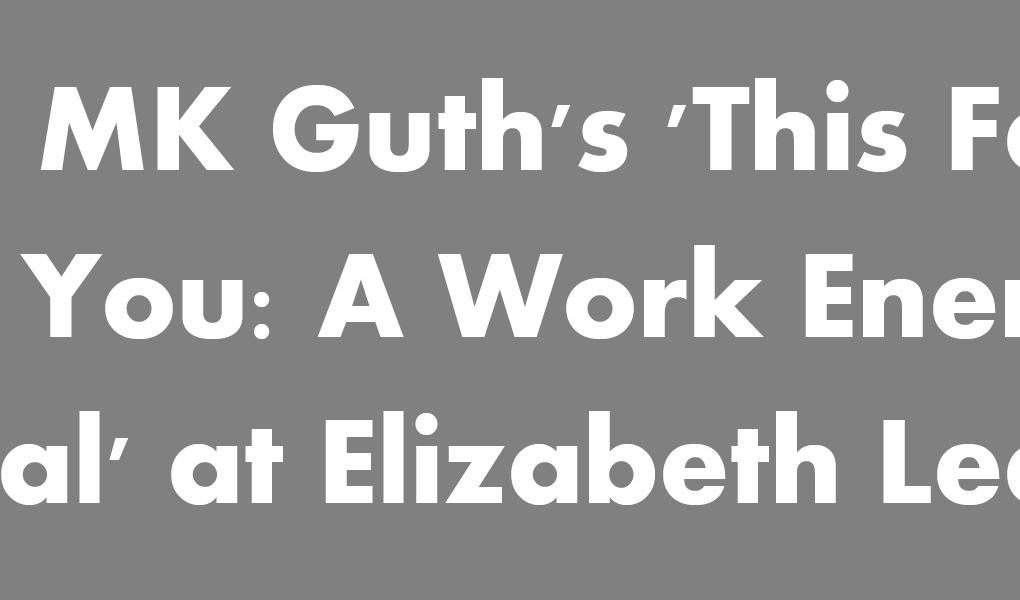“Busy Bodies: MK Guth’s ‘This Fable Is Intended for You: A Work Energy Principle: Final’ at Elizabeth Leach Gallery”
by Patrick Collier
Originally published by Oregon ArtsWatch August 9, 2016
It’s a bit sad, really, writing this review for MK Guth’s This Fable Is Intended for You: A Work Energy Principle: Final at Elizabeth Leach Gallery. I know I’ve missed something significant—something prior to the making of the sculptures presented. After all, it is Final, and indeed the last iteration of a body of work, the bulk of which exists only as documentation. It also seems to be the last of a decade’s worth of projects she has done that involve braiding. I regret I’ve missed them all except this one.

The progenitor of this current work, This Fable Is Intended for You: A Work Energy Principle, occurred in 2009 and 2010. Here is part of the description from the extensive catalogue created for Guth’s 2012 exhibit at Marylhurst’s The Art Gym: “…a public project at One New York Plaza… Guth invited New Yorkers to bring unusable fabric (old clothes, sheets, rags) to a storefront transformed into an artist studio. Over a five-week period, Guth worked with volunteers to take the materials apart…and weave the fabric into large ropes and sculptural shapes. Guth then choreographed a series of performances for the Under the Radar Festival, in which 24 participants used the ropes to create complex and evolving geometric shapes and patterns.” But this is all by way of providing background more than context for Final.
My sadness reminds me some of another exhibit I saw at Leach: Ann Hamilton’s last exhibit, which consisted of discrete objects, several that were elements of her magnificent the event of a thread at the Park Avenue Armory (where Guth has also exhibited) in 2012. Oh, to have seen Hamilton’s Armory event! From what I have read and seen online, it was epic. Consequently, Hamilton’s Portland exhibit at Leach felt like a remnant sale. (However, it did not lessen my admiration for her.)
This Fable Is Intended for You: A Work Energy Principle: Final consists of seven sculptures and two untitled ink on paper pieces. Only one sculpture, 2 Teenagers, and the works on paper (of course) are mounted on walls; the others are free-standing. All of the sculpture incorporate braids that have been stacked or wrapped and then sewn together to make the forms. For a moment I am reminded of the rag rugs I grew up with, handmade by my great-grandmother, and while this may provide a point of entry, any sense of nostalgia for me stops there.
Still, there is a sense of functionality in these sculptures, primarily because of the furniture and accessories used in conjunction with the braiding. Furthermore, the two ink-on-paper pieces and the use of a sconce as part of 2 Teenagers situate me within an interior space, not necessarily domestic yet populated. The “people” herein meld—more than blend—with their environment. The braided aspects of Molly and Fashion Designer are sort of lumpy, almost sinking into fuzzy ottomans as if they are longtime fixtures. Others like Wall Street Restaurant and Scooter Kid are considerably more animated, trying to break free from that which holds them, as if they were trying to escape the very thing of which they are composed. The 2 Teenagers threaten to tear up the place with their antics. Or so I make such assumptions, for few of the titles offer any clues. Instead, I hone in on the orifices and appendages of the pieces, and my imagination takes over.

Scores of contemporary artists incorporate fabric into their art assemblages. For instance (and I am aware that I am painting with a wide brush), draping often intends an immediate, intuitive (even slap-dash), or abstract feel. More craft-oriented techniques such as crochet seem to tend toward social critique. While both can be effective, they engage a viewer in ways distinctly different from how we react to Guth’s Final. Guth refers to her pieces as vessels, and if I may extend that imagery, it is the corporeality of her sculpture that actively—nearly literally—engages the viewer. They appear to get in your way, threaten to run you over, say “excuse me” or invite you to cozy up to them. In one’s mind the distance from the viewer to the artwork becomes a tad bit closer than the intellect—or for that matter empathy—might otherwise allow or prefer, which means they manage to carry over an element of the performative from their previous lives. And that makes me less sad.
Courtesy Oregon ArtsWatch.
Artist Credit: MK Guth, Patrick Collier.
